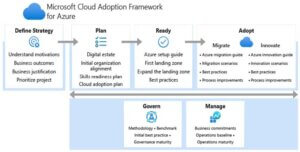1.1. Describe cloud computing

The skill “1.1. Describe Cloud Computing” is focused on providing a foundational understanding of cloud computing concepts and terminology. This includes the characteristics and benefits of cloud computing, as well as the various cloud deployment models and service types.
Cloud computing is a model for delivering computing resources and services over the internet. It offers on-demand access to a pool of shared computing resources, such as servers, storage, and applications, that can be rapidly provisioned and released with minimal management effort. The main characteristics of cloud computing include self-service provisioning, broad network access, resource pooling, rapid elasticity, and measured service.
The benefits of cloud computing include increased scalability, flexibility, cost savings, and operational efficiency. Cloud computing enables organizations to quickly and easily scale their resources up or down to meet changing demand, and pay only for what they use. It also enables faster time-to-market for new products and services, and frees up IT staff to focus on more strategic tasks.
There are three main cloud deployment models: public cloud, private cloud, and hybrid cloud. Public cloud is a model in which cloud resources are owned and operated by a third-party provider and made available to the general public. Private cloud is a model in which cloud resources are owned and operated by an organization and used exclusively by that organization. Hybrid cloud is a model that combines public and private cloud resources to create a single, integrated infrastructure.
Cloud service types include Infrastructure as a Service (IaaS), Platform as a Service (PaaS), and Software as a Service (SaaS). IaaS provides virtualized computing resources such as servers, storage, and networking. PaaS provides a platform for developing, testing, and deploying applications. SaaS provides fully functional software applications that are delivered over the internet.
Overall, having a good understanding of cloud computing concepts is essential for anyone working with cloud technologies, as it provides a foundation for making informed decisions about which cloud services and deployment models to use based on specific business needs and requirements.
Skill Exam Summary
0 of 20 Questions completed
Questions:
Information
You have already completed the skill exam before. Hence you can not start it again.
Skill Exam is loading…
You must sign in or sign up to start the skill exam.
You must first complete the following:
Results
Results
0 of 20 Questions answered correctly
Your time:
Time has elapsed
You have reached 0 of 0 point(s), (0)
Earned Point(s): 0 of 0, (0)
0 Essay(s) Pending (Possible Point(s): 0)
Categories
- Not categorized 0%
- 1
- 2
- 3
- 4
- 5
- 6
- 7
- 8
- 9
- 10
- 11
- 12
- 13
- 14
- 15
- 16
- 17
- 18
- 19
- 20
- Current
- Review
- Answered
- Correct
- Incorrect
-
Question 1 of 20
1. Question
For each of the following statements, select Yes if the statement is true. Otherwise, select No.
A private cloud must be disconnected from the internet.
CorrectIncorrect -
Question 2 of 20
2. Question
Note: This question is part of a series of questions that present the same scenario. Each question in the series contains a unique solution that might meet the stated goals. Some question sets might have more than one correct solution, while others might not have a correct solution. Your company plans to migrate all its data and resources to Azure. The company’s migration plan states that only Platform as a Service (PaaS) solutions must be used in Azure. You need to deploy an Azure environment that meets the company migration plan.
Solution: You create an Azure virtual machines, Azure SQL databases, and Azure Storage accounts.
Does this meet the goal?
CorrectIncorrect -
Question 3 of 20
3. Question
To complete the sentence, select the appropriate option in the answer area.
An Azure web app that queries an on-premises Microsoft SQL server is an example of a xxxxxx cloud.
CorrectIncorrect -
Question 4 of 20
4. Question
You have 50 virtual machines hosted on-premises and 50 virtual machines hosted in Azure. The on-premises virtual machines and the Azure virtual machines connect to each other.
Which type of cloud model is this?
CorrectIncorrect -
Question 5 of 20
5. Question
Identify two options from below that reflect two valid hybrid cloud infrastructures. (Select two.)
CorrectIncorrect -
Question 6 of 20
6. Question
The cost per subscriber for a cloud service provider reduces with the increase in number of subscribers. It is a public cloud service.
Can you identify what this would be called?CorrectIncorrect -
Question 7 of 20
7. Question
Identify a justification that validates the fact that Azure lowers a company’s capital expenditure costs.
CorrectIncorrect -
Question 8 of 20
8. Question
What is the first stage in the Microsoft Cloud Adoption Framework for Azure?
CorrectIncorrect -
Question 9 of 20
9. Question
For each of the following statements, select Yes if the statement is true. Otherwise, select No.
A company can extend an internal network by adding its own physical servers to the public cloud.
CorrectIncorrect -
Question 10 of 20
10. Question
For each of the following statements, select Yes if the statement is true. Otherwise, select No.
To achieve a hybrid cloud model, a company must always migrate from a private cloud model.
CorrectIncorrect -
Question 11 of 20
11. Question
For each of the following statements, select Yes if the statement is true. Otherwise, select No.
A private cloud must be disconnected from the internet.
CorrectIncorrect -
Question 12 of 20
12. Question
In which type of cloud model are all the hardware resources owned by a third-party and shared between multiple tenants?
CorrectIncorrect -
Question 13 of 20
13. Question
For each of the following statements, select Yes if the statement is true. Otherwise, select No.
Part of a hybrid cloud is the public cloud.
CorrectIncorrect -
Question 14 of 20
14. Question
For each of the following statements, select Yes if the statement is true. Otherwise, select No.
To implement a hybrid model. A company must always migrate from a private cloud model.
CorrectIncorrect -
Question 15 of 20
15. Question
Select the answer that correctly completes the sentence.
An Azure web app that queries an on-premises Microsoft SQL server is an example of a xxxxx cloud
CorrectIncorrect -
Question 16 of 20
16. Question
To which cloud models can you deploy physical servers?
CorrectIncorrect -
Question 17 of 20
17. Question
Match the cloud model to the correct advantage. (To answer, drag the appropriate cloud model from the column on the left to its advantage on the right. Each cloud model may be used once, more than once, or not at all.)
Sort elements
- Provides a choice to use a on-premises or cloud-based resources.
- provides complete control over security.
- no required capital expenditure
-
hybrid cloud
-
private cloud
-
public cloud
CorrectIncorrect -
Question 18 of 20
18. Question
For each of the following statements, select Yes if the statement is true. Otherwise, select N0.
A company can extend a private cloud by adding its own physical servers to the public cloud.
CorrectIncorrect -
Question 19 of 20
19. Question
For each of the following statements, select Yes if the statement is true. Otherwise, select No.
To build a hybrid cloud, you must deploy resources to the public cloud.
CorrectIncorrect -
Question 20 of 20
20. Question
“Select the answer that correctly completes the sentence.
_________in Azure enables you to deploy Azure resources close to the users.”
CorrectIncorrectHint
Because of geo-distribution you can deploy apps and data to regional datacenters around the globe, thereby ensuring that your customers always have the best performance in their region.
https://learn.microsoft.com/training/modules/fundamental-azure-concepts/benefits-of-cloud-computing

